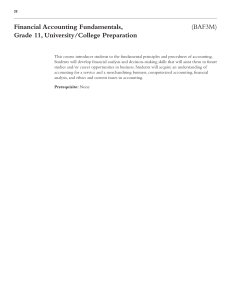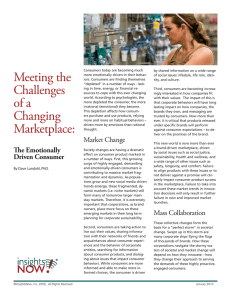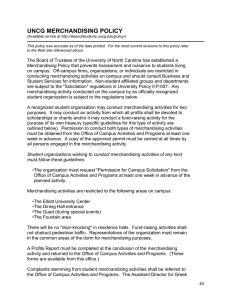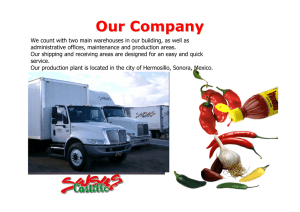Merchandising for Growth
Anuncio
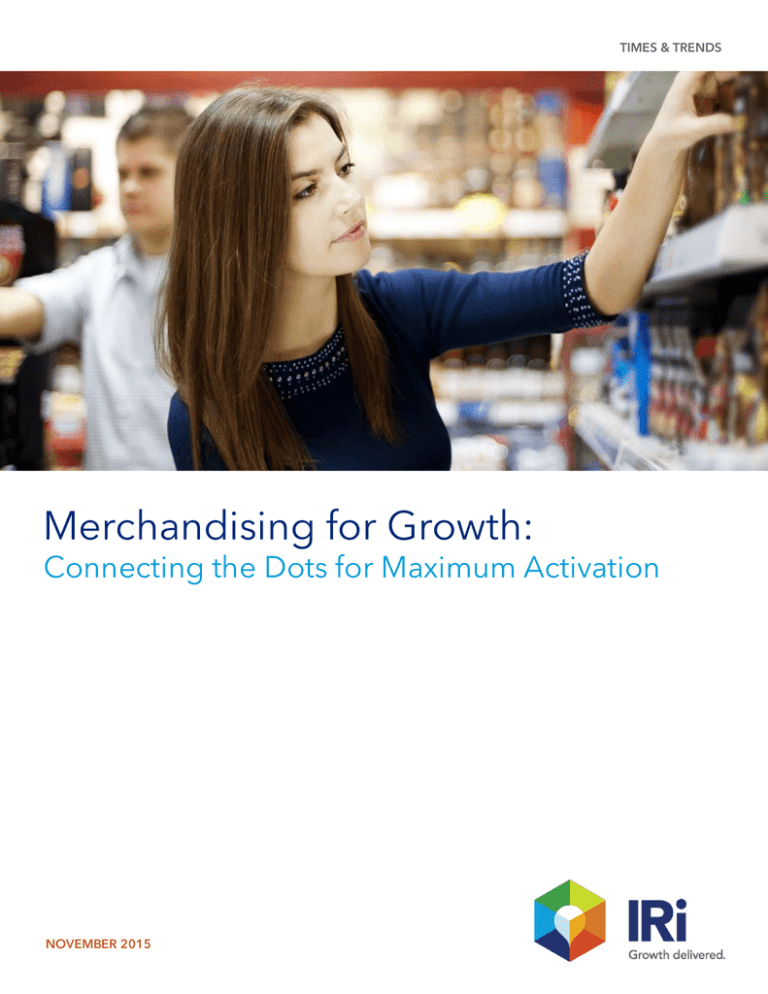
TIMES & TRENDS Merchandising for Growth: Connecting the Dots for Maximum Activation NOVEMBER 2015 MERCHANDISING FOR GROWTH: CONNECTING THE DOTS FOR MAXIMUM ACTIVATION TIMES & TRENDS Executive Summary: Creating Growth with a Fresh Start The CPG Industry Is Struggling to Generate Growth Despite Escalating Trade Support CPG volume trends are flat and industry growth is largely coming from price increases. Promotional activity is being used as a lever to drive engagement, with marketers funneling more and more resources into trade to increase promotional intensity and spur purchase behavior, all the while sales lift from said programs is on the decline. • During the past year, merchandising lift fell across 58 percent of CPG categories, including 72 of the 100 largest categories; • Erosion has been occurring for years, yet merchandising activity is up across 40 percent of CPG categories and promotional programs are recycled year after year; • The CPG industry is in trouble, and the time for change is now. Ground-Up Redesign of Price and Promotion Strategies Can Yield Up to 2 Percent in Annual Growth (up to $12 billion for the industry) CPG marketers must rebuild their strategies, beginning with the creation of a comprehensive pricing structure (price pack architecture) that cuts across the brand portfolio: • Broad and diverse product assortment at price points to meet the appetites of a wide spectrum of shoppers • Solid value proposition • Lasting competitive advantage, with improved profits and margin and solid customer loyalty. Capturing the Opportunity Requires Overcoming a Number of Challenges Getting it right is no easy task. Manufacturers and retailers have been resistant to turning away from their “old” pricing and promotion strategies. Taking a new path, they will be facing the following three challenges: • Price and promotion development has evolved into a highly complex process • There is a need to decipher vast amounts of data • There is no single clear-cut path to success Framework to Win To provide guidance to CPG marketers looking to redeploy pricing and merchandising strategies to support dollar sales and margin goals versus pure volume growth, IRI developed a robust Revenue Growth Management Suite™ that integrates data, technology and people to build a framework for strategies that will allow marketers to interact with consumers and each other in a powerful manner. IRI Revenue Growth Management will help you: • Create a 360-degree brand strategy • Understand and optimize the roles of different products within the portfolio • Ensure ongoing alignment with evolving consumer and channel dynamics IRIworldwide.com Copyright © 2015 Information Resources, Inc. (IRI). All rights reserved. 2 TIMES & TRENDS MERCHANDISING FOR GROWTH: CONNECTING THE DOTS FOR MAXIMUM ACTIVATION The CPG Industry Is Struggling to Generate Growth Despite Escalating Trade Support Exhibit 1 CPG Volume Sales Are Stagnant and Growth Is Largely Stemming from Price Increases Volume sales trends are on a flat-to-negative trajectory, with dollar sales growth being driven largely by price inflation. There is no question that The Industry Growth by Channel Compound Annual Growth Rate, 2012–2015 Great Recession had a profound and lasting impact on U.S. consumers and the CPG industry. Even several years post-recession, growth has proven evasive. Dollars Volume Avg. Price per Volume 2.9% 2.4% 2.2% 2.0% 1.5% Since 2012, CPG volume sales have 1.0% been on a flat-to-negative trajectory (See Exhibit 1). Dollar sales are up, driven by pockets of growth across -0.3% some branded categories. Strong pricing moves and innovation of products and attributes for which MULO consumers are willing to pay a premium are also playing a role. -1.0% -1.4% Grocery Drug Source: IRI Market Advantage™; 52 weeks ending 5/17/15 versus same period prior years The grocery and drug channels are Industry Growth by Sector, MULOC Compound Annual Growth Rate, 2012–2015 experiencing sharper-than-average volume sales declines, a testament Dollars to the highly competitive CPG Volume landscape and momentum gained by emerging channels. These trends were explored in detail in IRI’s recent 3.0% Avg. Price per Volume Inflation 2.3% 2.0% Times & Trends report, Channel * 2.0% 1.8% 1.3% Migration: The Road to Growth Has Many Lanes. 0.5% The non-food sector is faring only slightly better than food and beverage aisles. -0.7% Explored throughout this report, Food & Beverage Non-Food stagnant trends are not for lack of effort. Indeed, trade activity is strong and, in many cases, on the rise. *Note: U.S. Bureau of Labor Statistics. Consumer Price Index for Food at Home and Consumer Price Index for All Items except Food and Energy. Source: IRI Market Advantage™; 52 weeks ending 5/17/15 versus same period prior years IRIworldwide.com Copyright © 2015 Information Resources, Inc. (IRI). All rights reserved. 3 TIMES & TRENDS MERCHANDISING FOR GROWTH: CONNECTING THE DOTS FOR MAXIMUM ACTIVATION Exhibit 2 CPG marketers have been relying heavily on promotions to drive growth for several years; 2015 saw intensity escalate across nearly half of CPG categories. Based on % Volume, Any Merchandising % of CPG Categories with Increasing 47% Merchandising Activities 41% 40% MULO Grocery VOLUME SALES % CHG VS. YA* (0.5%) (2.0%) (0.2%) DOLLAR SHARE OF CATS. WITH INCREASING MERCH. ACTIVITY 39% 31% 62% *Note: Drug Drug channel volume change across top 100 categories, based on dollar sales. Source: IRI Market Advantage™; 52 weeks ending 5/17/15 versus same period prior years Volume Declines Continue average, is sold with merchandising with an average 39 percent of volume Despite Intensifying Reliance support, defined as feature only, sold with merchandising support on Merchandising Support display only, feature and display, or during the past year. Reliance on price-only tactics. These efforts are promotions is up across 47 percent Promotions have long played a key focused on many of the largest CPG of drug categories, and 59 of the 100 role in informing and influencing categories. During the past year, largest categories. CPG shoppers. Today, 45 percent of reliance on merchandising activity consumers will stock up on certain to move volume continued its The reality is, packaged goods items when they are on sale and 28 escalating trend, increasing across marketers are investing heavily in percent of consumers will buy a 40 percent of categories, accounting promotional efforts, in the hopes of brand other than their preferred for 39 percent of dollar sales, with spurring brand, category, and brand when it is on sale.1 even sharper upticks in the grocery industry growth. Unfortunately, the and drug channels. results of those efforts are not what In packaged goods aisles, sales and marketers had hoped—volume is flat promotional activity abounds. More The drug channel shows an above- than one-quarter of volume, on average reliance on merchandising, to negative nearly across the board. Source: 1IRI MarketPulse Survey Q2 2015; 2015 Brand & Retailer Loyalty Survey IRIworldwide.com Copyright © 2015 Information Resources, Inc. (IRI). All rights reserved. 4 TIMES & TRENDS MERCHANDISING FOR GROWTH: CONNECTING THE DOTS FOR MAXIMUM ACTIVATION Exhibit 3 Escalating Support Spans Tactics; Price- and Display-Only Tactics Are Most Pervasive Promotional intensity is escalating across tactics and channels, with food and beverage relying more heavily on price actions and non-food turning more to display activity. While promotional activity is increasing across channels and % of Categories with Increased Merchandising Activity by Merchandising Tactic, Multi-Outlet tactics, non-food aisles are disproportionately impacted by MULO this trend (See Exhibit 3). Grocery are receiving more investment in 49% 44% 46% percent across multi-outlet; slightly less in grocery and drug channels) Drug 56% About half of CPG categories (56 31% 30% 49% 48% 41% 36% 29% 47% 40% 41% 34% display-only efforts, looking to get products placed throughout the store to get more eyeballs, compensate for abbreviated traffic flows and stand apart from competing products in their “typical” shelf location. Feature & Display Display-Only Feature-Only Price-Only Any Merchandising Source: IRI Market Advantage™; 52 weeks ending 5/17/15 versus same period prior years This trend is particularly evident in non-food aisles, where two-thirds of categories, including paper towels, % of Categories with Increased Merchandising Activity by Merchandising Tactic & CPG Sector, Multi-Outlet batteries and dog food, are seeing more display-only actions. 44% Price Only 51% In food and beverage aisles, heightened display-only activity is surpassed only by price actions. Half of edibles categories (51 percent) moved more volume with price-only Feature & Display support during the past year than they did the prior year. Several of the Feature Only largest edibles categories, including milk, eggs and breakfast meats, saw 69% Display Only Any Merchandising huge jumps in price-only actions, as 45% 33% 30% 31% 27% 46% 35% Non-Food Food & Beverage marketers sought to minimize negative impacts of inflationary pressure. Source: IRI Market Advantage™; 52 weeks ending 5/17/15 IRIworldwide.com Copyright © 2015 Information Resources, Inc. (IRI). All rights reserved. 5 TIMES & TRENDS MERCHANDISING FOR GROWTH: CONNECTING THE DOTS FOR MAXIMUM ACTIVATION Exhibit 4 Despite increasing investment in merchandising, lift has been on the decline for several years, and there are clear indications of continued erosion. % of CPG Categories With Reduced Merchandising Lift, 2015 Average Merchandising Lift by Channel, 2012 & 2015 -5 pts. 2012 68% 187% 182% 2015 58% 48% -9 pts. -13 pts. 108% 89% MULO Grocery Drug 78% MULO 95% Grocery Drug Source: IRI Market Advantage™; 52 weeks ending 5/17/15 versus same period prior years In 2012, 39 percent of categories were getting lift Lift from Trade Activity Is Sliding, lift fall. Meanwhile declines in drug with No End in Sight were a bit more restrained, occurring across 48 percent of categories. of 90 percent or more from During the past year, lift from merchandising efforts. merchandising support declined Erosion of lift is not new; it has been Today, only 30 percent across 58 percent of CPG categories occurring for several years. In fact, (See Exhibit 4). during the past few years, average achieve lift of this magnitude. lift is down nine points across IRI’s Declines are occurring across retail multi-outlet geography. channels. The grocery channel, for instance, saw more widespread declines versus the industry as a whole during the past year, with 68 percent of categories seeing average IRIworldwide.com Copyright © 2015 Information Resources, Inc. (IRI). All rights reserved. 6 TIMES & TRENDS MERCHANDISING FOR GROWTH: CONNECTING THE DOTS FOR MAXIMUM ACTIVATION Exhibit 5 Lift is down across three-quarters of the largest CPG categories, many of which rely heavily and increasingly on merchandising for product movement. CPG Categories With a Significant Drop in Merchandising Lift , Multi-Outlet, 2015 CHANGE IN % VOLUME INCREASE W/ ANY MERCH. SUPPORT Coffee % VOLUME WITH ANY MERCH. -16.3 Sports Drinks -15.3 Breakfast Meats -11.9 % VOLUME WITH ANY MERCH., PT CHG VS. YA 40% (3.0) 49% +0.3 50% +8.9 Kitchen Storage -10.4 15% +0.9 Paper Towels -10.2 41% (0.7) Milk -5.8 25% +4.8 Toilet Tissue -5.6 38% +0.5 Beer/Ale/Alcoholic Cider -5.3 41% (1.2) Soap -5.1 31% (0.6) 52% +2.0 Salty Snacks -4.0 Source: IRI Market Advantage™; 52 weeks ending 5/17/15 versus same period prior years Falling Lift Is Widespread, and Pervasive Across the Largest CPG Categories. Lift from merchandising support has declined across 72 of the 100 largest CPG categories during the past year. This trend is cutting across the store, with many categories seeing double-digit losses in sales lift Breakfast meats, for instance, rely on The coffee sector saw volume sales merchandising for about half of their decline 1.9 percent during the past volume movement. Marketers in this year, following several years of rather category increased merchandising strong growth. This sector has activity during the past year in an benefitted from trends around attempt to stave off losses from at-home/from-home dining and the escalating prices. Breakfast meats explosive growth of k-cups. met with some success, supporting Innovation in this area continues and volume growth of 4.1 percent. is well-received, as demonstrated by IRI New Product Pacesetter while investment in merchandising brand Peet’s K-Cup Packs, but continues to escalate (See Exhibit 5). merchandising activity has cooled and lift is down sharply. IRIworldwide.com Copyright © 2015 Information Resources, Inc. (IRI). All rights reserved. 7 TIMES & TRENDS MERCHANDISING FOR GROWTH: CONNECTING THE DOTS FOR MAXIMUM ACTIVATION Exhibit 6 Even among stock-up categories, which generally receive significant lift from merchandising support, lift has been eroding. CPG Categories by Significant Merchandising Lift, Multi-Outlet, 2015 % VOLUME INCREASE W/ ANY MERCH. SUPPORT Paper Towels % VOLUME WITH ANY MERCH. CHANGE IN % INC. IN VOLUME W/ MERCH. 41% (10.2) 128% Spaghetti/Italian Sauce 122% 33% (5.8) Chocolate Candy 121% 52% (1.5) SS Seafood 121% 37% +3.2 Hair Conditioner 118% 29% (2.1) Pasta 115% 39% (5.7) Toilet Tissue 115% 38% (5.6) Ice Cream/Sherbet 113% 51% (6.6) Butter/Butter Blends 106% 48% (30.0) Cold Cereal 106% 38% (6.2) Source: IRI Market Advantage™; 52 weeks ending 5/17/15 versus same period prior years Many Categories That Rely on The shelf-stable seafood category struggles CPGs face is evidenced Merchandising to Drive Stock-Up saw reliance on merchandising here. During the downturn, Purchases Are Feeling the Pinch activity increase sharply during the consumers embraced a conservative past year, as marketers sought to approach to living—sharing products, Some categories—often referred to alleviate pressures of rising prices. stretching usage, limiting purchases as stock-up categories—tend to These efforts helped to maintain to needs over wants. Consumers are respond very well to promotional modest volume growth (up 1.2 not inclined to purchase more than efforts. The chart at the top of this percent), and lift from merchandising they need simply because a product page illustrates examples of 10 efforts climbed nicely. is on sale, particularly in a category categories that receive substantial like hair conditioner, where packages lift from merchandising efforts (See Meanwhile, most of these high-lift Exhibit 6). Reliance on merchandising categories have seen sales lift from activity has increased across many of merchandising efforts fall during the these categories during the past year. past year. One of the ongoing IRIworldwide.com have been upsized in recent years. Copyright © 2015 Information Resources, Inc. (IRI). All rights reserved. 8 TIMES & TRENDS MERCHANDISING FOR GROWTH: CONNECTING THE DOTS FOR MAXIMUM ACTIVATION Ground-up Redesign of Price and Promotion Strategies Can Yield Up to 2 Percent in Annual Growth Exhibit 7 CPG Marketers Must Take a Step Back and Rewire Price and Promotional Strategies Take a step back and retool price pack architecture to increase sales revenue by tens of millions of dollars. from the Bottom Up. There is no question about it: It is Dollar Value 1 to 2 Percent Boost in Revenue Across Select CPG Categories, Multi-Outlet, $ Millions, 2015 time for change. But, it is critical for CPGs to view this change as an opportunity, rather than the enemy. This change is an opportunity to win. Today, ineffective merchandising $130 to programs are leaving substantial sums of money on the table across CPG aisles. While the magnitude of opportunity lost varies by channel, $250 A top salty snacks manufacturer $90 to $175 A top carbonated beverage manufacturer category and brand, opportunity losses of tens of millions of dollars are not uncommon. CPG marketers who rewire their price pack architecture (PPA) to deliver surgically executed competitive pricing strategies will win Source: IRI Market Advantage™; 52 weeks ending 5/17/15 versus same period prior years DEFINITION Price Pack Architecture, or the basic pricing structure of a brand portfolio. A successful pricing architecture provides consumers a viable selection of products that meet their needs at the price points they are willing to pay, driving portfolio growth and enhancing a brand’s overall value proposition. big—they will carve out solid growth in a slow-growth environment. Getting pricing architecture right will In fact, IRI estimates that getting Getting pricing architecture drive a 1 to 2 percent increase in price pack architecture right across right will drive a 1 to 2 percent topline sales, bringing hundreds of all categories would result in industry millions of incremental sales to CPG’s sales lift of $6 to $12 billion. increase in topline sales. largest categories (See Exhibit 7). IRIworldwide.com Copyright © 2015 Information Resources, Inc. (IRI). All rights reserved. 9 MERCHANDISING FOR GROWTH: CONNECTING THE DOTS FOR MAXIMUM ACTIVATION TIMES & TRENDS Capturing the Opportunity Requires Overcoming a Number of Challenges Manufacturers and Retailers Have mindset during any number of trip As a result, CPG marketers often Been Hesitant to Enter Uncharted missions, data about products and revert to making one tactical move Price and Promotion Territory channels, data about the entire after another, rather than taking a path to purchase. But, data don’t step back and asking how to rebuild CPG marketers are reluctant to adopt necessarily paint a clear path of price and trade strategy to survive in a new approach to price and effective merchandising design, ideal today’s CPG marketplace. This is a promotion. After all, there is comfort merchandising timing and clear short-term solution to a long-term in the “known,” particularly when it customer focus. problem, and its effectiveness is comes to complex processes such as limited and shrinking. these. In the areas of price and promotion, there are a lot of considerations. The industry is replete with data—data about the shopper and the shopper IRIworldwide.com Copyright © 2015 Information Resources, Inc. (IRI). All rights reserved. 10 TIMES & TRENDS MERCHANDISING FOR GROWTH: CONNECTING THE DOTS FOR MAXIMUM ACTIVATION To Fully Capitalize on Growth Opportunities, Take the Road Less Traveled An Effective Price Pack Architecture Will Create True and Lasting Market Advantage Generally speaking, today’s Exhibit 8 An effective price pack architecture (PPA) will integrate four distinct pricing elements to clearly identify future goals and ensure effective trade spend. promotion-related decisions are being made in isolation and in a very tactical manner, and this practice is Anatomy of an Effective Price Pack Architecture feeding the downward spiral in promotional effectiveness. To be effective in today’s more nuanced and complex CPG environment, marketers need to take a step back to redevelop promotional programs. Price pack architecture (PPA) must become a first input into the system, for it ensures that the portfolio underscores brand equity across the board and creates a rising tide that lifts all boats. PPA is influenced by four critical Brand strategy: The goal of the made it more challenging for elements: portfolio strategy, brand brand strategy is, of course, to marketers to build and maintain strategy, channel dynamics and position the brand to win in the most strategies that will maximize return consumer needs. promising markets. Having a simple and minimize risk. Marketers must and clear value proposition is keep a keen focus on emerging Portfolio strategy: A product absolutely critical. For each brand, channels. They must also segment portfolio generally has a mix of ask: what role does this brand play their customer base to determine products with different growth rates in the product portfolio? Is this a which channels and which customers and different market shares. The goal premium brand or a fighter brand? are most important to each of of the portfolio, of course, is to help If it’s a premium brand, it is vital to their brands. the brand and the company grow, maintain a premium positioning in ultimately driving share and price. If it’s a value brand, the same Consumer needs: Having a clear shareholder profits. To get there, it principle applies. understanding of consumer needs isn’t necessary to promote all brands. and wants is absolutely essential. For Rather, the portfolio strategy is to Channel dynamics: The path to each brand, marketers must invest to surgically assess the role of different purchase has changed dramatically understand which attributes are most brands within the portfolio and during the past few years. This valuable to their key consumers. identify those that are most likely to metamorphosis has made marketers’ Those attributes, in turn, must be benefit from promotional activity. jobs more exciting, but it has also reflected in all promotional efforts. IRIworldwide.com Copyright © 2015 Information Resources, Inc. (IRI). All rights reserved. 11 MERCHANDISING FOR GROWTH: CONNECTING THE DOTS FOR MAXIMUM ACTIVATION TIMES & TRENDS Exhibit 9 Marketers who embrace a more comprehensive approach to promotion planning will see higher lift, stronger loyalty and top-line growth of 1 to 2 percent. Many of today’s CPG marketers are relying on an old-school, tactical approach to promotion planning. They consider only a handful of elements, such as business conditions, retail terms and conditions and some tactical factors. Effective promotional strategies must consider price pack architecture and all of the elements that influence it. Marketers that embrace this more comprehensive approach to promotional planning will enjoy higher lift, stronger loyalty and top-line growth of 1 to 2 percent. IRIworldwide.com Copyright © 2015 Information Resources, Inc. (IRI). All rights reserved. 12 TIMES & TRENDS MERCHANDISING FOR GROWTH: CONNECTING THE DOTS FOR MAXIMUM ACTIVATION Exhibit 10 Leverage responsiveness to base vs. promoted price to set pricing tactics for a brand, category, and product. More Responsive to Promoted Price Everyday Price/Promo Responsiveness Quadrants Drive Margin Quality Frequency Low Base/High Promoted Elasticity High Base/High Promoted Elasticity Hi-Lo Strategy: Enhance margin on base price (everyday) and drive share by leveraging promotional effectiveness through deeper promoted price points Hybrid Strategy: Need to strike a balance with maintaining an attractive shelf-price (base price) positioning, while driving share through promotional discounting Less Responsive to Promoted Price Price Protect Promoted Depth Low Base/Low Promoted Elasticity High Base/Low Promoted Elasticity Niche/Premium Strategy: Conserve trade dollars and margin to enhance brand equity through appropriate marketing communications and product innovation strategy EDLP Strategy: Consumers are more focused on shelf price than on promotions, adopt an EDLP positioning with appropriate value-oriented marketing communication Less Responsive to Everyday Price More Responsive to Everyday Price CPG Marketers Can Leverage missions considerations will also promotions to break through IRI’s Full Suite of Elasticity Solutions come into play. the clutter and drive consumer to Establish a 360-Degree View of Price Elasticity engagement, even if promotional Investing to understand whether price elasticity is low. volume is driven by price or With a clearly defined price pack merchandising is critical. Again, this is Meanwhile, where promotional architecture in place, marketers can not a one-size-fits-all question—all price elasticity runs high, it makes turn their focus to striking a balance products and brands are not equal, sense to allocate spending to trade between everyday pricing and trade so a surgical approach to dissecting efforts. This means investing to pricing. That balance will vary impacts of price is essential. understand not just products to across—even within—categories. After be merchandised, but also depth, all, marketers must consider the fact Close examination of influencing frequency and timing, and the that consumers are often willing to factors is needed. For example, interplay of those factors on switch (including to private label) to seasonal categories rely on merchandising lift. save money. Channel and trip IRIworldwide.com Copyright © 2015 Information Resources, Inc. (IRI). All rights reserved. 13 MERCHANDISING FOR GROWTH: CONNECTING THE DOTS FOR MAXIMUM ACTIVATION TIMES & TRENDS Framework to Win CPG volume trends are flat and industry growth is largely coming from price and promotion programs. Promotional activity is being used as a lever to drive engagement, even though sales lift from promotional efforts is eroding, and has been for the last few years. The dynamics of pricing and promotion are changing. Marketers must embrace today as the start of change—an opportunity to step back and integrate pricing and promotional architecture as a key part of their price-promo strategies. IRI’s comprehensive Revenue Growth Management Suite™ combines a unique combination of predictive analytical techniques, proprietary rapid modeling platforms, leading-edge automated solutions, a vast and granular CPG data set, and experienced analytics to deliver a lasting impact on the marketplace and improve the return on trade promotion investment. IRI’s Revenue Growth Management Program Will Help You Win in the Marketplace: Today a lot of pricing and promo decisions are made tactically based upon the immediate market conditions. Leaders do not view these in isolation and integrate with their market positioning. There are three key elements of this: (a) the equity of Create a 360-degree brand strategy the brand, (b) the unique benefit that the product provides to the core shoppers during high–gain shopping occasions, and (c) the overall channel and retailer strategy. Integrating these key elements will drive a more “surgical” price-promo strategy and improve the ROI from this spend. Having the right portfolio strategy is key to success. This includes understanding Understand and the role of different products within your portfolio—e.g., which are the value brands optimize the roles of that you would “fight” competition with and which are your premium brands where different products you would take price and build profit with. You can build growth and strengthen within the portfolio profits by analyzing and reallocating funds across your portfolio. It is important to carefully monitor evolving channel dynamics and adjusting price-promo strategies in real time to align to these changes. Invest to establish and Ensure ongoing maintain an intimate understanding of the evolving path to purchase for your key alignment with evolving consumers and target shoppers to ensure your touch points are woven tightly consumer and channel throughout the purchase process. Finally, understand the role of “traditional” and dynamics evolving channels and the impact on consumer buying behavior. Potentially divert your spend across channels toward areas with the highest impact. IRIworldwide.com Copyright © 2015 Information Resources, Inc. (IRI). All rights reserved. 14 MERCHANDISING FOR GROWTH: CONNECTING THE DOTS FOR MAXIMUM ACTIVATION TIMES & TRENDS Resources If you enjoyed this report, you may be interested in the following IRI products and services, which work cooperatively to provide actionable insights and recommendations around high-gain price and promotion strategies: For sales and channel management that Powered by IRI Liquid Data, IRI Market Advantage enables better, faster goes beyond the “what” to deliver the “how” decisions with a broader level of marketplace insight than ever before by and “why,” tap into IRI Market Advantage™ delivering all edible and non-edible categories in multiple business views, ranging from total store, departments and aisles to eating occasions, corporate portfolio and brand franchise—all drillable to the individual UPC level—as well as the ability to customize category definitions and detailed product segmentations. For robust trade analytics and planning, IRI Trade Planner’s two solutions — the Event Planning Calendar and Post turn to IRI Trade Planner™ Event Analyzer — provide a seamless flow from post-event ROI analysis to flexible trade plan development and simulation. To understand key factors that drive sales By enabling a view across time, products, markets and drivers, users and impact change, count on IRI Business can drill into the key insights to develop strategies that will replicate and Value Drivers™ amplify past successes, as well as address lost opportunities. To gain a comprehensive understanding Leveraging IRI’s revolutionary Liquid Data Platform, Price & Trade of your product’s price sensitivities, gaps, Advantage gives insight on price sensitivities, gaps, thresholds, competitive thresholds and behavior in comparison to implications, and sales volume decomposition to maximize sales and create your competitors, rely on IRI Price & Trade the most effective pricing and trade plans at retail. Use these robust, simple, Advantage™ and integrated planning applications to get actionable insights at the execution level for continuous, repeatable results. For advanced analytics and deep growth Fueled by IRI’s proprietary and granular data, integrated with external data strategy capabilities to inform and drive and advanced analytics, IRI Growth Consulting helps clients achieve their your unique growth strategies, turn to IRI growth targets through identifying sustainable and profitable pockets of Growth Consulting growth – demand spaces, shopper cohorts, channels, retailers and geographic regions – and developing organic activation and acquisition strategies to enable access to these pockets of growth. IRIworldwide.com Copyright © 2015 Information Resources, Inc. (IRI). All rights reserved. 15 MERCHANDISING FOR GROWTH: CONNECTING THE DOTS FOR MAXIMUM ACTIVATION TIMES & TRENDS FOR MORE INFORMATION Please contact Susan Viamari at [email protected] with questions or comments about this report. ABOUT THE AUTHOR Susan Viamari is vice president, Thought Leadership in the Chicago office of IRI. You may contact her by email at [email protected]. ACKNOWLEDGEMENTS Contributors to the development and analysis of this report include John Porter, executive and practice leader, Retailer Productivity; Sharat Mathur, practice lead, Revenue Growth Management; and Ray Florio, partner, Growth Consulting. Porter, Mathur and Florio are all part of IRI’s Strategic Analytics group and based in the Chicago office of IRI. About IRI IRI is a leading provider of big data, predictive analytics and forward-looking insights that help CPG, OTC healthcare, retailers and media companies to grow. With the largest repository of purchase, media, social, causal and loyalty data, all integrated on an on-demand cloud-based technology platform, IRI guides over 5,000 clients globally in their quests to remain relentlessly relevant, capture market share, connect with consumers and deliver growth. www.IRIworldwide.com. Corporate Headquarters: 150 North Clinton St., Chicago, IL 60661, USA, (312) 726-1221 Copyright © 2015 Information Resources, Inc. (IRI). All rights reserved. IRI, the IRI logo and the names of IRI products and services referenced herein are either trademarks or registered trademarks of IRI. All other trademarks are the property of their respective owners. IRIworldwide.com Copyright © 2015 Information Resources, Inc. (IRI). All rights reserved. 16
